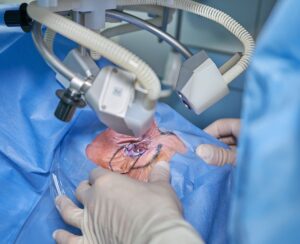Are you tired of having to wear glasses or contact lenses every single day? Do you wish there was a way to achieve clear vision without wearing glasses or contact lenses? If you answered yes to those questions, don’t worry — you’re not alone and many people feel the same way.
The good news is there is a wide range of vision correction surgeries designed to improve vision problems on an outpatient basis. Most of them only take a few hours to complete and have an extremely high success rate, especially with the recent improvements in technology.
Your eye doctor will perform a thorough and comprehensive eye exam in order to determine which type of vision correction surgery you need. This will largely depend on what type of refractive error you’re experiencing and what type of condition your eye health is currently in.
So, what is a refractive error?
Believe it or not, refractive errors are the most common type of vision problem in the United States and they impact more than 150 million Americans. Normally, your eye doctor will prescribe eyeglasses or contact lenses to help improve your vision so you can see clearly.
Refractive errors are caused by an abnormal corneal surface or eye shape. The cornea, as well as the eye’s natural lens, are responsible for focusing light rays into the back of the eye — the retina. Light is then converted into an electrical signal that travels to the brain via an optic nerve.
When light isn’t being focused properly, it’s likely due to a refractive error. Of course, there are four types of refractive errors that eye surgeons will be on the lookout for during an eye exam — nearsightedness (myopia), farsightedness (hyperopia), astigmatism, and presbyopia.

Nearsightedness (Myopia)
Nearsightedness, also known as myopia, is when your near vision is sharp, but you experience blurry vision at a distance. This is due to the eye being longer from front to back or the cornea being too curved. Instead of the light being focused on the retina, light focuses in front of the retina.
Depending on the results from your eye exam, your doctor will either diagnose you with mild nearsightedness, moderate nearsightedness, or severe nearsightedness.
Farsightedness (Hyperopia)
Farsightedness, also known as hyperopia, is when you can see distant objects clearly, but experience blurry vision when trying to see up close. This is due to the eye being shorter from front to back or the cornea being too flat. Light is focused behind the retina instead of on it.
Doctors will determine whether you’re experiencing mild to moderate hyperopia based on how much worse your near vision is to your distance vision.

Astigmatism
With astigmastism , patients are experiencing blurry vision from any distance — both far away and up close. It’s generally caused by an abnormal shape of the cornea, lens, or both — which leads to light not being focused onto the retina properly. It’ll continue to get worse over time.
There are several different vision correction surgeries that can correct astigmatism, but your doctor will have to determine which one is safest and most effective for your eye condition.
Presbyopia
Presbyopia is most common in older adults and is also referred to as an aging eye. Due to the natural aging process, which we all experience as we get older, the eye starts to lose function and eventually loses the ability to focus properly. It’ll generally occur around the ages of 40-50.
Unlike other refractive errors, there’s no corrective eye surgery that will improve presbyopia. Although refractive surgery can improve distance vision, it may make near vision worse.
Different Types of Refractive Eye Surgery
Now that we understand what refractive errors are and how they can impact good vision, you’re likely wondering what the different types of refractive eye surgery are. They can all reduce your reliance on corrective lenses, whether that be eyeglasses or contact lenses.
While there are plenty to choose from, the most popular forms of refractive surgery are LASIK eye surgery, photorefractive keratectomy, refractive lens exchange, implantable collamer lens, and radial keratotomy. Let’s take a closer look at each one and how they correct vision.
LASIK Eye Surgery
LASIK surgery can correct myopia, hyperopia, and astigmatism, which is why it’s the most popular type of surgical correction. A femtosecond laser creates a thin layer of tissue called a corneal flap. After the cornea is re-shaped with another laser called an excimer laser, the thin flap is replaced.
There are various different types of LASIK eye surgery , also known as Laser-Assisted In Situ Keratomileusis. This includes all-laser LASIK, custom LASIK, bladeless LASIK, EPI LASIK, and Wavefront-Guided LASIK — which utilizes wavefront technology.
Photorefractive Keratectomy (PRK)
Photorefractive keratectomy, also known as PRK, utilizes an excimer laser to correct nearsightedness, farsightedness, and astigmatism. There is no flap involved, so patients who enjoy combat sports like mixed martial arts, boxing, etc, have a job that may involve head trauma (like police officers) , or those with thinner corneas may be a great candidate for PRK. The laser removes tissue from the cornea to reshape it. It’ll only take a few minutes to complete and the healing process generally takes a few days to weeks.
Refractive Lens Exchange (RLE)
During a Refractive Lens Exchange, also known as RLE, the doctor uses ultrasound technology to remove the eye’s natural lens. Then, the doctor inserts an artificial lens — also referred to as an intraocular lens (IOL) to replace it. This surgical procedure is extremely similar to cataract surgery.
Implantable Collamer Lens (ICL)
An Implantable Collamer Lens, also known as ICL, is very similar to RLE surgery. It involves the use of new implantable lenses, though it works in a way that doesn’t involve removing the eye’s natural lens. It’s best reserved for younger patients that aren’t suffering from presbyopia.
Radial Keratotomy (RK)
A Radial Keratotomy is where the doctor makes a small incision in the cornea with a scalpel. Although an RK used to be a common way to correct myopia (nearsightedness), this type of corrective eye surgery has largely been replaced by LASIK or other types of laser eye surgery.

Contact Your Local Eye Surgeon Today!
Refractive errors can make your life extremely difficult, especially since vision plays an integral role in our ability to live happy, healthy, and normal lives. Luckily, there are various different types of corrective eye surgery that can help restore vision loss or vision impairment.
If you’re interested in learning more about these surgeries or want to schedule a comprehensive eye exam to begin the process of correcting your own vision, Milwaukee Eye Surgeons is ready and willing to serve you. Contact us today and we’ll be honored to help improve your vision.



